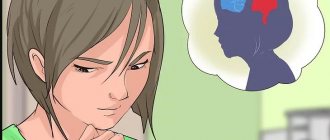Psychology of color
It is worth talking about the meaning of colors in psychology. The facts are well known how marketers use colors to increase store sales, how stylists select not only the clothes themselves, but also their shade for a person in order to attract the attention of others. These and other phenomena are studied by color psychology. The definition of colors in psychology and their influence on a person occurs primarily due to their effect on her mood and emotions. For example, when a person looks at dark blue, the number of beats of his heart per minute decreases and his breathing slows down. From this we can conclude: dark blue is a calming color, it gives peace and tranquility. Orange, on the contrary, increases blood pressure, speeds up the heartbeat, and gives a person some stimulation. Of course, colors act on the nervous system, on which all human life depends.
Visual perception of color
A person’s constant predilection for one shade or another is explained by his character. A person has always liked red, but suddenly he buys a gray item, regardless of the meaning of the colors of the clothes. In psychology, this phenomenon is explained simply: he’s used to red and wears it all the time, but he bought gray because at that moment his mood told him, a certain surge. It turns out that with the help of color, you can change your mood. Those who have had a bad look lately tend to look at darker shades. The choice happens intuitively. If the mood is high, then a person needs bright colors.
You and me
As psychology experts assure, the significance of the color red cannot be underestimated. It is important for building normal relationships between people. The traditional reading is love, desire, desire, feelings, passion. Red is called a symbol of the beginning of a new life. It is believed that the shade gives protection to women and protects people. Many interpret him as the patron saint of mothers and wives. For a long time, they resorted to red products to protect the husband from the evil thoughts of surrounding and envious outside women.
Luscher color test
Max Lüscher is a professor and psychologist from Switzerland. He devoted his scientific activity to studying the provisions of color diagnostics. It was he who came up with the test named after him, built on the basis of functional psychology. So what is the meaning of color in psychology according to Luscher? First of all, the professor emphasized that the structure of color, and therefore its meaning, remains unchanged. This means that whether a person likes dark blue or not, it still means “peace.” Luscher decided to consider the very attitude of people to the color scheme. And if each person sees it in his own way, then perhaps the meaning of colors in psychology also varies.
Application overview
iOS
Luscher test and personality psychology. Determining mood by color The appendix presents both short and full versions of the Luscher test.
Before starting testing, you need to enter your first and last name, read the instructions and select the type of test. The application is free. The results can be shared on social networks. Color test - psychological analysis of personality using the Luscher method
Dinis Ishmukhametov
Price: Free
Download
Price: Free
Psychology of gray
Gray is a sign of neutrality, middle ground. The person who chooses it for himself does not take into account the meaning of colors in human psychology. She wants to stay away from everything outside. Such people prefer not to open up to others; they keep everything to themselves. This does not mean that they are tense or relaxed, they are simply in the middle, in neutral territory. This is the desire to isolate yourself from everything, to remain untouched.
Those people for whom gray comes last consider it very boring and monotonous. They prefer to enjoy life and enjoy bright colors. This is in some way connected with an irresistible desire to be constantly involved in some kind of activity.
Psychology of blue
Blue color has always symbolized peace and harmony. Scientists have proven that when a person looks at objects made in blue tones, he calms down. At this time, his body prepares for rest and relaxation. This shade carries a harmonious state and symbolizes unity with the world. The meaning of colors in psychology, especially blue, dark blue, indigo, cyan, contains associations with silence and peace.
Blue matches calm waters, a phlegmatic person, femininity, and tenderness. Many scientists believe that it has material completeness. Obese people most often give their preference to this particular shade. If during the test a person rejects the color blue, it means that he is running away from peace and trust, his need for this remains unsatisfied. This may indicate that he does not want to become attached to something and cannot afford to waste time on this, since, in his opinion, such an act entails giving up something very important. Relaxation can lead to depression, which many people try to stay away from. Usually they are constantly tense, and are in search of external stimuli, doing everything to ensure that a state of peace never occurs, because this can lead to a lifestyle devoid of meaning.
LiveInternetLiveInternet
The most famous “color” test was invented by a scientist named Luscher. He suggested that a person's emotional state and ability to adapt to a situation can be determined by a person's attitude towards certain colors. The full version of the test consists of 73 colors, and the procedure for conducting and interpreting it in this form can only be done by a professional psychologist. Therefore, we will focus on an abbreviated version, which allows us, albeit not so accurately, to still determine our internal state. Preparation The abbreviated Luscher test includes 8 colors, which the author divided into primary (blue, green, red and yellow) and additional (purple, brown, black and gray).
To conduct the study, you need to prepare cards with these colors, put them in front of you (or someone else you want to test) and choose one at a time: first the one you like the most, then, turning over the first one, the next most preferred one, and so on. . After which the resulting “color range” is evaluated as follows. Let's count in order. The most attractive color indicates what a person needs most at the moment to achieve life goals. The second most important color shows what that goal is. The third and fourth characterize the state and well-being at the moment. The fifth and sixth indicate what is not relevant for a person at the moment (but is typical and sometimes relevant in life). The seventh and eighth (the most unsympathetic) reveal to us the secrets of the subconscious - they talk about needs that are present, but due to some circumstances cannot be satisfied now. Reading by colors And now we come to the most interesting thing - the “interpretation” of colors.
Blue , which occupies the first position, symbolizes calmness, the desire for agreement, understanding, trust, lack of conflict, friendship and devoted love. If this color is further than third, it indicates dissatisfaction with the relationship and a desire to end it. In addition, if it is in the last two positions, and red , then perhaps the person is trying to cope with problems in his personal life through a large number of “intimate partners”. In a similar situation, but in combination with the “preferred” yellow , we can talk about an active, productive, constant search for a solution to a relationship problem. A preference for green occurs when a person strives for self-affirmation, power, recognition and superiority, self-confidence and independence. Dislike for green speaks of a high degree of excitement, the inability to realize these aspirations, resentment and humiliation, and the inability to stand up for oneself. Red is the color of activity, attack, struggle. It is chosen by leaders and creative individuals, those about whom they say “wants to take everything from life.” Dislike for red means overexcitation and depletion of vitality, irritation and the need for a strong patron. Yellow is the color of dreamers who want to find a miraculous solution to life's troubles. They are characterized by an easy approach to life, avoidance of responsibility and problems in general. Rejection of yellow speaks of disappointment and despair, loss of trust, and the emergence of suspicion. Here we can clarify that if, with yellow , we see green , then we have a person striving for a high social status, and if red , he is an adventurer. Purple is most often chosen by emotionally immature or unstable people. They are characterized by a strong desire to be liked, to receive approval, understanding, support, as well as an inadequate, unrealistic perception of reality. If we find purple in the last positions, then it speaks of suppression of feelings, rationality, control and self-control. Brown is the color of sensual pleasure. He talks about the desire for comfort and security, about the current weakness, fatigue, hunger, and illness. Rejection of brown is usually associated with denial of the importance of physical needs and strict self-restraint. black symbolizes aggression, refusal, complete rejection, protest, complete dissatisfaction with one’s life and the willingness to recklessly fight current circumstances. By the position of the color black, you can determine what is most important for a person - usually this is what the colors in the positions preceding it symbolize. It is clear that blacks “have a place” in the positions of “rejected”. The gray color speaks for itself. If we want to, we prefer to hide from life’s adversities, to hide, to avoid participation. When he is at the end of the color range, we have a responsible and active person.
All colors are divided by type of movement:
- Eccentric (yellow)
- Concentric (blue square is alarming).
Each color has many meanings. There is an interaction between color and time - each era chooses its own color: gray - Puritanism and post-war Britain, Ancient Rome - purple as a symbol of power. A very large variety of flowers - the nation is thriving. There is also a school of color healing. The ancient Greeks were the first to think about this: when passing through a temple window, the color is divided into a spectrum, so a person absorbed the color that he wanted. In Ancient China, lying in the sun in red silk was a cure for traces of smallpox. In the 18th century, stained glass was common in Europe. If a person is tired of one color, then he needs to look at the opposite one, that is, the state changes to the opposite. Red always affects physical condition, yellow - on health. mental, and blue - for emotions. Their shades also influence accordingly. The preferred color gives an idea of the current state, the rejected color gives information about the reasons that encourage you to make mistakes. For example, blue is loved by people who prefer to relax and not by workaholics.
Short test The first color, called a person, characterizes the personality at the moment, the second color is a working color, the third shows relationships with others, how a person treats them.
1.White color This color is afraid of black. Causes positive associations, because A small amount of color appears.
| Positive characteristics | Negative characteristics |
| Intact Completeness Self-giving Openness Unity Lightness Ability to reveal the hidden and false | Isolation Futility Boredom Stiffness Frustration Detachment |
White color is characterized by perfection and completeness, demonstrating an absolute and final decision, complete freedom for possibilities and the removal of obstacles. Its fundamental quality is equality, because contains all colors, they are equal in it. It always inspires, helps, inspires a certain faith (gives freedom). If there is a lot of white, its negative characteristics come into force. In mythology, white is often used in Africa - it was worn by priests, because... protected and gave the opportunity to enchant. White was the color of social harmony and peace. If you sacrifice a white animal, it is a truce pact with the gods (it is best to sacrifice an albino human). If you paint the inside of a house white, there will be peace in it; if you paint the doorposts white, a person entering will leave his evil outside. White is very widely used in Christianity as a symbol of faith, purity, truth and lordship. White color in clothes means the beginning. The white wig of a judge is a symbol of justice. “white knight” is a symbol of salvation. A white coat (in a hospital) is also considered a symbol of salvation and sterile cleanliness. White color controls the functions of the endocrine and visual systems. White clothes make the skin much softer and more delicate. Treatment with white color is carried out only in combination with other colors - depending on the disease. White color brightens, renews all colors in the body, and helps remove stiffness. But! Children's rooms should not be painted white.
2.Black color Exists in contrast to white, absorbs all colors around and never releases them.
| Positive characteristics | Negative characteristics |
| Motivated use of force Creation Ability to foresight Meaningfulness | Destructiveness Suppression Depression Emptiness Use of power as a manifestation of weakness and selfishness |
Black always hides everything that it carries, that is, it is “mysterious” (often used in horror films). Black color is associated with curiosity, it attracts to itself. Frightens (fear due to mystery). The color black always challenges a person to try to free his essence, that is, a person must go through black in order to know how much white there is in him. Black gives a chance to rest, contains a promise - “everything will be fine”, hope, but at the same time you must remember that it will not let you go as you were before - it delays, but does not force you to do anything. When depression sets in, only the negative characteristics of the color black remain. He always, like death, speaks of silence and tranquility, it means the end. In mythology, also widely used in Africa - associated with the rainy season (the color of trees and water) - denotes a feeling of the unknown, mystery, hard work. Offering a black animal is a call for rain. Black marks on the body are a disease. Preference for black in clothes - lack or absence of something very important in life - a person covers himself with black. It is necessary to move out of black gradually, diluting it with other colors. Black and white colors together cancel each other out, no longer carry their original information, and do not put pressure on the psyche. You should pay attention to the age at which black is rejected. As a rule, black color is chosen when depression sets in and others are rejected.
3.Gray color
| Positive characteristics | Negative characteristics |
| Awareness Sanity Realism Union of opposites | Fear of loss Melancholy Illness Sadness Depression |
The gray color combines the opposite qualities of black and white, therefore, it feels unnecessary and alien and will never become the first (since it has no internal desire for this). The only goal is stability and harmony (due to exhaustion and fatigue). Gray color is considered lonely because... lives on the border of black and white. People who prefer gray do not believe that emotions can solve anything, do not believe in the sincerity of emotional experiences; believe that emotions can only be shown in certain circumstances (but not now). Hence their emotional restraint and, consequently, exhaustion. The gray color always stabilizes the processes around it, but it always looks divided and always feels bad. In the negative meaning of color, there is never a future for him - he is old, sick, no one needs him, he is always missing something. In its positive meaning, the color gray is confident that the best is ahead, but does nothing for it. In mythology and art, the color gray is little used. If gray color predominates in clothing, a person tends to strive to find ideal feelings and sensations (positive feelings that give inner harmony and relaxation). This color gives strength to those who are weak and vulnerable. Clothing gives you the opportunity to be free and calms your nerves well. As a rule, this color is worn for nervous exhaustion. Gray color on the body (skin) indicates illness.
Shades
Light gray acts very easily, expresses freedom and an elevated psychoenergetic state, readiness for contacts, calms well, pacifies both the body and mind (strives for white). His style of movement is restlessness (ghost color).
Dark gray has a calm and heavy effect, the excitement in it is inhibited and muffled. People who prefer dark gray are characterized by increased sensitivity; their need for mental and physical satisfaction dominates. This color expresses the constant struggle of the mind with causeless anxiety (it is devoid of internal energy - characterized by such expressions as “clipped wings”, “killed, broken, but still alive”). Such people suffer from their sensitivity and reject sensual heart connections, because... cannot withstand the influx of energy.
Black, white and gray are achromatic colors. The general rule for all colors is that if 3 colors are used, then one more of the achromatic colors must be used.
4. Silver It comes out of the gray, expresses the desire for freedom and an attempt to overcome all restrictions.
| Positive characteristics | Negative characteristics |
| Lighting Reflection Penetration Impartiality Smoothness Strong desire | Duplicity Illusionary Falsehood Madness |
Silver color is durable and reduces anxiety. It always flows slowly, frees you from emotional constraint, and is distinguished by its ability to penetrate everywhere. Has the ability to stop arguments (due to impartiality) and indicates that a person likes to fantasize. In its negative meaning, the color silver is usually associated with the inability to make decisions, with self-deception, illusions about current events (“I don’t know whether I’ve already arrived or am already leaving”). The color silver is often associated with the lunar path. A person who loves this color does not accept responsibility. In mythology, the color silver was associated with a silver thread that held the soul and body together. Treatment with silver color: it calms the nerves, normalizes the functioning of the endocrine glands, and has a beneficial effect on the functioning of the kidneys.
5.Pearl color It symbolizes luxury, gives strength, and can clear the mind. The properties of this color come from the pearl : it opens when it itself likes what is happening around it, hence its isolation, mystery and inner warmth. A person of this nature does not tolerate importunity and prefers to remain silent; he is outwardly closed and inaccessible - “in his own mind.” Such a person makes a mostly negative impression on others. In healing, this color promotes digestion.
6.Red color
| Positive characteristics | Negative characteristics |
| Leadership Persistence Fight for your rights Creation Dynamism Perseverance Pioneership | Physical violence Lust Intolerance Cruelty Destruction Stubbornness |
The red color represents power, breakthrough, the will to win, he always achieves what he wants (depending on the shade - the method of achievement). He is always on the move, always a source of energy. Red loves to be the first, but it cannot always be - it depends on its destructive qualities. The motto of this color is “let the fittest survive.” Red color makes you alert in case of danger, symbolizes passion, excites passion, i.e. passionately loves, passionately hates and passionately believes. Thus, he is characterized by maximum feelings. The red color is always practical and does not like to beat around the bush (it never persuades - it comes and takes); eager to get somewhere. He is prone to impulsive actions, without prior thinking - the so-called “bull in a china shop”. This color forces you to be active in everything, inspires and gives strength to continue what you started; represents victory, the ability to strike correctly. The color red governs sexual relationships and is stronger in this aspect than religion. It pushes towards sexual intimacy even if there is no true attraction. In the positive aspect - passion, in the negative - perversion. Red seeks justice, but is content with only its appearance. Due to his high activity, he is a good reformer. Such a person must be constantly convinced that he is the first, if not, then he will destroy everything, prolong the war, without thinking about the victims (he is an egoist). In the positive aspect, such a person is a soldier who gives his life for a goal; in the negative - a tyrant and murderer. This color always attracts attention, it is demonstrative. In mythology, the color red is used a lot: the God of War in red (aspect of cruelty); in Africa - meant “I love you immensely”, kings and leaders in Africa were dressed in red (only they could pass a death sentence), the red color was associated with the hot season and loss of self-control. The crusaders' heraldry expressed love for God and neighbors, but also rage and cruelty. In Christianity, scarlet is a symbol of splendor and shed blood. In ancient tribes, the body of the deceased was painted red - activity even after death. Red color promotes the functioning of the endocrine glands, the production of adrenaline, is associated with the reproductive organs, and affects body temperature (increases). Makes muscles elastic and joints mobile.
Shades
Scarlet strongly stimulates sensuality, has a stronger effect than red. The problems caused by this color are the tendency to make irrevocable decisions and fanaticism (people strive to conquer only the highest peaks).
Raspberry - it has a slight bluish tint; this color does not fight life, but loves it, does not believe in the effectiveness of the struggle, but goes and takes what it wants. Typically deals with individuality. But he carried it in droves. Such people are extremely sincere and believe in the power of words. The problems of this color are impulsiveness and unpredictability.
Fiery - it has a yellow-orange tint; distinguished by extreme zeal, rushes forward, regardless of the goal (yellow). Characterized by willpower and ardor. His problem is that he is too ardent in his zeal - he leaves scorched earth behind him, burning himself too.
Red-brown is distinguished by calm self-confidence and enthusiasm, not designed to create an external impression (brown extinguishes demonstrativeness). With an increased preference for this color, overwork and exhaustion are noted. The main problem is lack of determination.
Dark burgundy (almost brown) inherited willpower from red, and from brown a tendency to deep thought. His problem is the ability to dwell on long-past unpleasant events.
Dark red people. Those who prefer this color very often ask the question “why is this necessary?”; They are characterized by the saying: “God gives nuts only to toothless monkeys.” These people are overly indulgent, especially in sexual relationships (connivance). At the same time, leniency can develop into cruelty. The problem is inertia and rigidity.
7.Pink color
| Positive characteristics | Negative characteristics |
| Friendliness Femininity Maturity | Frivolity (weakening the influence of red) Putting yourself on display |
Pink color means romance, kindness, love, passion. The paler it is, the stronger the expression of love. Causes a feeling of comfort, calms, relieves obsessive thoughts, helps in a crisis. But! - He is characterized by excessive sensitivity.
The color of an orchid (light lilac) in a positive aspect - highlighting a bright individuality, in a negative aspect - excessive exoticism, inflexibility, the motto - “all or nothing”.
Red - purple . Such a person does not recognize slavery; he takes everything he needs delicately and carefully; suffers from the “it used to be better than now” syndrome, that is, he lives mainly in the past. This color makes you feel better. In the negative aspect - impersonality and lack of individuality.
red test - the desire to live life to the fullest, the desire for new experiences, hard work; I have no desire to rest now. Rejection of red is interpreted as overexcitation, mental and physical exhaustion. In adolescents - at the onset of peak sexual development.
8.Yellow
| Positive characteristics | Negative characteristics |
| Dexterity Intelligence Originality Joy of life Sensitivity Tolerance Honesty Self-confidence Justice Freedom Joy Fun | Acrimony Sarcasm Perfidy Absent-mindedness Love of chatter Criticality Intolerance Tendency to judge others The color of gossip (yellow press) |
Yellow color spreads in all directions, personifies the mind, the influence of the dominant. It is the most flexible, penetrates everywhere, helps overcome difficulties, promotes concentration (therefore, it is advisable to take exams in the yellow room). Under the influence of yellow color, a decision is quickly made and carried out instantly. People who prefer this color do not like fools, fight others with words, like to be admired, and do not like to be driven into a corner. They are characterized by high self-esteem, self-confidence, and activity. Yellow symbolizes intuition and intelligence. In mythology, yellow represents the Sun, warmth, spring and flowers. Jews were branded with yellow, the combination of yellow and black is a danger (tiger coloring, a sign of radiation), among the people yellow tulips are symbols of separation. For treatment - against melancholy - lily bulbs, against kidney disease - immortelle. To “increase” beauty - an infusion of yellow flowers (they also treat jaundice). In clothes, if yellow predominates, “there is nothing else to wear,” “bought it, wear it.” If you want to wear yellow, it means establishing inner harmony, saving you from troubles, the desire to consciously influence something (you cannot wear it when applying for a job). The main need of people who prefer yellow is to open up and show themselves; they are looking for an open relationship in order to share internal tension and achieve what they want. Yellow color eliminates false shyness and thoughts like “I’m not good enough”; evokes positive associations in advertising.
Shades
Red - yellow : in it the influence of yellow becomes more significant. Expresses spontaneity and impulsiveness, destruction. Yellow channels the power of red.
Lemon yellow : cruelty and unrestraint; has an antimicrobial effect. People who prefer this color have unconventional thinking, insight, criticality, always control themselves, avoid criticism and compromising situations. This color is chosen by frigid women and impotent women (but not 100%).
Light yellow : tendency to avoid responsibility, tendency to simulate.
Pale yellow:
freedom from limits
.
Brown - yellow (honey): combines the lightness of yellow and the heaviness of brown. The need for a happy and complete, enjoyment of the situation.
Gold is the color of glory, inevitable victory. He does not sacrifice himself and does not accept victims, he remains himself (he does not need anything). Positive aspect – maturity, experience, wisdom, vitality, inexhaustible resources; negative aspect - pessimism, limitation, dishonor. A golden halo above your head is a symbol of forgiveness and a way to overcome all obstacles. Gold unites the modesty of a child and the wisdom of a true ruler. But! – it can provoke conflicts.
9.Orange color
| Positive characteristics | Negative characteristics |
| Strength Inexhaustible energy Love of freedom Excitement Tolerance (quenches the aggressiveness of red) | Forgiveness Deliberation High self-esteem (demonstrative behavior) |
This color is responsible for satisfying various abilities and constantly keeps you in good shape; has all the capabilities of red, but without the aggression. His power is very gentle. The effect it produces is warm, joyful and exciting. The vital power of red allows orange to displace all colors. This color is associated with the desire to achieve self-affirmation. Orange is the color of warmth, bliss, intensity, but at the same time – the soft shine of the setting sun. It always pleases the eye and promotes a good mood. Almost always has a beneficial effect, because shows the joyful sides of life (as opposed to blue). In psychodiagnostics, orange is used to distinguish between red-yellow and yellow-red. Positive attitude towards red-yellow in hyperthymic people. They are brilliant but unevenly gifted; amaze those around them with their flexibility and versatility of their psyche; they are often artistically gifted. They have kindness and responsiveness; are usually in a good mood. But! At the same time, they are characterized by superficiality, instability of interests, and a constant need for hobbies. Yellow-red color is preferred by people with a cycloid type of accentuation. They are characterized by periodic changes in states of excitement and depression. Among the Celts, the goddess of youth and love wears yellow and red clothes (she owns rejuvenating apples). The warlike power of Mars and Saturn, orange is also symbolized with volcanoes - flowing energy. In psychotherapy, orange strengthens the will; supports sexuality, activates the work of the endocrine glands. Orange regulates metabolic processes, treats the genitourinary system, improves blood circulation and skin color, has a beneficial effect on digestion, increases appetite and causes a feeling of euphoria. It provides support in cases of bereavement or grief; brings lost balance. At the first moment of loss, a person rejects this color, because... cannot understand what happened, considering it unfair. Color should be introduced gradually. Orange gives the ability to do something and is considered one of the best colors in psychotherapy.
10.Green color
| Positive characteristics | Negative characteristics |
| Stability Progress Commitment | Selfishness Jealousy Hypochondria (constant feeling of illness) |
Green color comes from the fusion of blue and yellow, while the qualities of both are complementary. From here comes peace and stillness. Green always contains the possibility of life; it does not have externally acting energy, but contains potential energy - it is not at rest, but reflects an internal tense state. It expresses a person’s attitude towards himself; does not demand anything and does not call anywhere (looks past everyone). He hides all his secrets within himself and inspires stability. Symbolizes prosperity and new beginnings. People who prefer this color, as a rule, see both sides of a situation and know how to weigh and evaluate the chances of a favorable outcome; They are able to suppress with their authority and are distinguished by high efficiency. They remember only what is needed, and they tend to help other people, even to their own detriment. They are friendly, but very secretive; they have their own world, which they do not reveal to anyone. In its negative aspect, it is the color of silent approval and hopelessness. It is a color that cannot be looked at for a long time - it causes boredom, because... does not give anything. Treatment - has a beneficial effect on people suffering from claustrophobia. Green neutralizes the effect of other colors; helps dispel negative emotions. Brings calm and tranquility, helps to concentrate and make decisions, helps with shock and has a hypnotic effect.
Shades
The more blue, the stronger, colder and more intense the effect of the color. The more yellow, the lighter and more harmonious the color is.
Blue-green (turquoise) is the coldest of all shades, used to create a refreshing coolness, the color of sterility.
Dark blue-green - rejected during nervous exhaustion; personifies cruelty and heaviness, creates a feeling of isolation. It is preferred by those who place too strict demands on themselves, elevate their views to a principle and achieve its observance with irreconcilable consistency.
Yellow-green , the hidden energy that was in green is released. People who prefer this color strive to establish as many contacts as possible, constantly want to meet other people and learn new things. Next to white, this shade gives the impression of being strict and businesslike; as a rule, they try to dilute it with gray - to remove the intrusiveness.
Brown-green (green+black+yellow+red) – expresses sensual passivity. Such people would like to enjoy a state that has a beneficial effect on the senses and promotes relaxation; seek excitement through pleasure.
The darker the green, the more withdrawn the person. Green color is preferred by those people who strive, thanks to firmness and stability, to acquire a manner of confidently holding themselves. They strive for confidence. Green is rejected during physiological exhaustion.
11. Blue color This is a concentric color, it devotes everything only to itself.
| Positive characteristics | Negative characteristics |
| Organization Inflexibility Idealism Fortitude | Fanaticism Subordination |
This color has “no bottom”, it never ends, it draws you in, intoxicates. At the same time, the power of color is underestimated. It creates the precondition for deep reflection on life; calls to find meaning, truth. But! does not provide an answer to understanding the meaning of life; drives melancholy and weakness. It evokes not sensual, but spiritual impressions. Blue color is constancy, perseverance, perseverance, devotion, dedication, seriousness, rigor. People who prefer this color try to put everything in order and systematize. They always have their own point of view; They are devoted to what they do, their devotion to people can reach the point of slavery. In myths, blue is a divine manifestation, the color of mystery and value. Blue color – loss of reality, daydreaming, fanaticism. Mages and wizards are dressed in blue. In the Middle Ages, people who wore blue knew the truth. In Ancient Egypt, the inside of the pyramid was painted blue. The beetle is a blue beetle. Buddha and Krishna are blue. The blue color in the flags is freedom, unification, belonging to a larger whole. Treatment – helps restore the nervous system; helps with absent-mindedness, increased heartbeat, intestinal upset, nervous tension, calms raging passions, extinguishes emotions, lowers blood pressure. People experiencing prolonged stress and tension reject the color blue. It is also generally rejected by smokers. Blue is chosen by those who are tired of tension, who want harmony with others, with their nervous system.
Shades
Blue is the color of carelessness, it calms, radiates reliability, but at the same time, looking at it, it is impossible to concentrate. It does not promote the development of imagination. Reduces stress and is comfortable. This is the color of “calm emotionality”; makes it possible to be outside the boundaries of society, expands space. But! slows down growth and development. This is the color of dreams and daydreams, the color of peace and harmony.
Dark blue (indigo) is the color of dreams. It is very deep, leads to depression, causes a depressing effect, anxiety, excessive seriousness, sadness, sadness. Causes the need for physiological peace and contentment in the world. Rejection of this color is when you do not want to relax and unwind.
12.Brown color
| Positive characteristics | Negative characteristics |
| Reliability Common sense | Depression Disappointment |
This is a darkened yellow-red color: the impulsive vital force of red is restrained, freezing. In brown there remains a vitality that has lost its activity. Expresses the vital sensations of the body. People who prefer this color desire physical rest and peace. Health conditions are ignored when brown is rejected. The color brown represents stability, loyalty (it has a positive effect when hiring); it's all on the surface. Calms and supports during times of anxiety and worry. It is chosen for nervous exhaustion, when a person feels that the conflict situation is insoluble. It is rejected when a person wants to find his own individuality, get away from the instincts of the body, stop depending on them. At the same time, people need categoricalness and attention.
Shades
Yellow-brown is the color of hard work and rigor.
Cream has a soft effect, expands space, makes it easier to perceive reality, and gives confidence that everything will be in order.
13.Violet Formed by red and blue, which cancel each other out. Red finds its resolution in blue, and blue its meaning in red. Hence the veiled excitement. This is the color of pregnant women. Denotes sensuality, which stands on the verge of individuality and is defined as suggestibility. This is the color of idealism and helps increase self-esteem. In myths - in the Middle Ages - the color of repentance. The cardinal's ring contains purple amethyst, a symbol of abstinence. Purple is a heavy color. It must be diluted with gold, otherwise it can lead to depression. Not recommended for working with children; reduces heart rate. 75% of children who have not reached puberty and 85% of mentally retarded children are accepted. This color is loved by homosexuals; Because of the veil, pregnant women choose. Preference – when there is a need for identification with someone, sentimentality. Such people are completely surrendered to their feelings. Also, this color is chosen by lower-class Lyuli, because... They cannot find the strength to realize themselves. This color is rejected due to a penchant for sensuality and eroticism; such people are afraid of losing independence; they have rational control of their emotions, as well as a critical look at their own emotions and actions.
Shades
Dark purple symbolizes rudeness and authority.
Lilac (light purple) calms anxiety, symbolizes intuition; has a mild, non-intensive effect, improves vision (pansies contribute to this).
Lilac – vanity, immaturity, chosen in adolescence.
Combinations Yellow-green expresses the desire to find respect in one’s own eyes and in the eyes of others, all activities are aimed at gaining attention.
Orange - black expresses danger, fear (black color absorbs).
Yellow - black is a pleasant combination, but yellow - the need to realize yourself, when combined with black, results in “realization into nothing” - this is a combination of suicides.
Red - yellow expresses activity.
Red and black expresses aggression.
Black - green - these colors are for themselves.
Brown-green expresses perseverance, reflection, and does not lead in activity.
Orange-white The power of orange is tempered by white.
Blue and white expresses calmness.
Brown-blue leads to endless bodily relaxation.
Interior
White - should be avoided in hospitals and nurseries.
Yellow is preferred in the airplane cabin, kitchen, and exam rooms.
Brown - creates coziness but encourages relaxation - cannot be used in the library, good to use in court (as the color of inviolability).
Blue – preferred for boardrooms – promotes organization; negative for children's rooms - melancholy.
Red – positive in a cafe (customers leave quickly) .
Pale blue is positive in the bathroom, bedroom; helps contain fans' emotions.
Dark green is positive in non-residential rooms, in the library, that is, where they spend a lot of time.
Pale pink (peach) is advisable to use in the bedroom, rest room (it’s easy to get up in the morning); evokes coziness and comfort, but does not drag on.
Series of messages “COLOR”:
About color and its influence on humans
Part 1 - The color of flowers, their language and the meaning of color. Part 2 — CANDLE MAGIC Part 3 — “Color Choices” according to Luscher Part 4 — Working with mandalas, yantras, Arcturian codes Part 5 — EXOTIC OCEAN INHABITANTS… Part 47 — About the kind, instructive, floral… Photographer Christine Ellger. Part 48 - Meditation with the colors of the rainbow Part 49 - The color of luck.
Psychology of green
The effect of the color green is also considered an important component in the interpretation of the concept of “the meaning of colors.” In psychology, it is believed that people whose spiritual attachment is dissatisfied try to compensate with this particular paint. It symbolizes independence. Sympathy for her is often found among young people who want to quickly become independent. It is a symbol of constancy and perseverance, a certain degree of cruelty, firmness and perseverance. People who choose green are very wary of change. They strive to increase self-confidence in their skills and abilities through self-affirmation. They can gain sympathy from others, for example, due to their financial status.
This shade controls a person to some extent. A person may feel pride, superiority over others, and a desire to control other members of society. Green lovers tend to think a lot about health and how to increase their life expectancy. They defend their principles, sometimes suffering from the fact that they do not receive recognition from other people. As for those for whom green is in last place, we can say that they have lost the strength to fight. This may lead them to blame others for their mistakes. Those who reject the color green are people who have lost self-control and patience, resulting in impulsive behavior.
Psychology of red
People who want to experience sexual intoxication choose red or its shade of crimson. The significance in psychology shows that they are primarily looked at by individuals who crave exciting experiences and emotions. Shades of red symbolize vitality. They increase blood pressure and improve appetite. People who love red want to experience the fullness of life. Those who put it first are involved in sports and wrestling. This is the color of masculinity, aspiration, fire, spiritual strength, conquest. Also means sexual desire. People who have red in last place feel threatened by it because they lack vitality. They most often choose blue as a compensating color to enhance calmness. At the same time, attachment to him becomes painful due to failures in love.
Psychology of yellow
Often the rejection of blue causes a person to choose yellow. The meaning in psychology is associated with a burdening attachment that requires relief in order to eliminate depression. Unsatisfied emotionality forces a person to continually look for a way out of the situation. It is a search for satisfaction and harmony, an attempt to find the meaning of life and a place where you can use your capabilities to the maximum. Yellow color is the brightest, liveliest and lightest. Associated with stimulation. The pulse and breathing increase, just like with red.
The main advantage of yellow is its brightness and unconscious positivity. It indicates a person’s desire to free himself from heaviness, from something that oppresses him. People for whom this color comes first hope for happiness and expect it in all forms and manifestations. They want to achieve recognition and respect. Well, those who put yellow as last, as a rule, are disappointed in life, in hopes, in people. They stand face to face with emptiness. Due to the brightness inherent in yellow, it can be rejected due to overexcitation, as a result of which a person feels irritable, angry, distrustful of people, and is constantly in a bad mood.
Psychology of purple
People choosing a color scheme may not appreciate the meaning of lilac. In psychology, it indicates a person’s increased emotionality, as a result of which he can anticipate some actions or events. Purple is a mixture of red and blue, unbridled energy and calmness. Two opposing forces. The color violet is responsible for the love of magic and the desire to possess it. The meaning in psychology is explained, on the one hand, by a person’s dreams of sensual merging with a partner, and on the other hand, by isolation, because there are no prerequisites for this.
Situations and meanings
Considering the red color in the interior within the framework of psychology, we found that such a color has a positive and strong effect on a person in the morning. Surrounding yourself with scarlet objects makes it easier to cheer up. It is easier for a person to wake up, and the morning begins with a positive emotional mood. Starting a new day, a person is full of strength, cheerful and capable of new achievements. This is suitable for ambitious people. It won’t hurt to cheer yourself up with a red interior if you have a situation in which you need to show yourself cheerful. So, if negotiations are planned, the conclusion of a very significant deal, a color shake-up will not be superfluous.
It is known that red is an assistant in the erotic sphere. This color is associated with excitement. Thanks to interior items and the appropriate environment, it is easier for people to tune in to interaction. Traditionally, red is used in the interior of the rooms of young spouses. Such paints are chosen for dyeing underwear and bedding. The most luxurious is red natural silk. It is considered a classic and perhaps the most reliable means of arousal.
Psychology of brown
Scientists have long studied the psychology of color. The meaning of color in the clothes chosen by a person very well describes his essence. Brown color is a mixture of yellow and red with shading. All the unbridledness of red in it is muted, suppressed. It is put in first place by people who lack vitality. Everything around them is perceived passively. Brown symbolizes the sensory perception of the world and makes it clear how a person relates to physical sensations. He has an increased need for rest, for creating comfort and peace around himself. If brown is in last place or the color is rejected altogether, the person is seen as an individual trying to distinguish himself from the crowd. As a result, it can cause the attention of obsessive sexual people.
Curious to know
Color specialists and experts in the field of traditional medicine recommend using red stones to maintain your health. Bright scarlet varieties are considered especially useful. It is worth paying attention to scarlet varieties of coral. However, everything should be in moderation. By surrounding yourself excessively with such products, you can disrupt your own mental state. A person around whom there are too many red objects quarrels with others more often, he is more aggressive. It is believed that such persons tend to misunderstand the motives of others, and it is more difficult for them to build productive interactions with other people.
Psychology of black
Black expresses a highly controversial meaning of color. Meaning and psychology, combining into a single whole, give the idea that it is the darkest and is always associated with mourning and depression. Since for many this color symbolizes a certain border, it expresses “nothing, complete denial. Black gives a person the desire to defend himself and repress irritants. This is a refusal and a contradiction at the same time. A person for whom this color comes first is capable of giving up everything. Those who put black in last place do not want to endure hardships, place high demands on themselves and avoid danger.
Everyday life and different ages
Observations have shown that red foods are beneficial for the human body. Their regular use allows you to cleanse the body of harmful compounds. Appetite improves, the likelihood of bowel dysfunction decreases. Foods that are naturally red are believed to be good for the liver. A diet containing an abundance of such food is recommended for the treatment of depression and helps to cope with melancholy. Such a diet is considered an additional measure for the treatment of nervous disorders; it is indicated for patients with smallpox.
Red foods are beneficial for children because most of these foods contain beneficial compounds that are indicated for anemia. Such products combat poor appetite and relieve apathy. If your child is underweight, including plenty of red foods in their diet will help them gain a few pounds.











